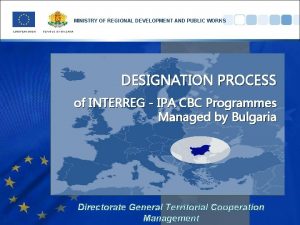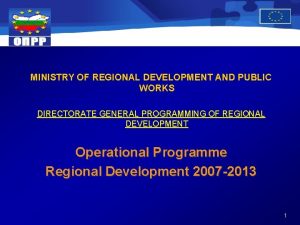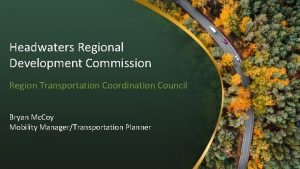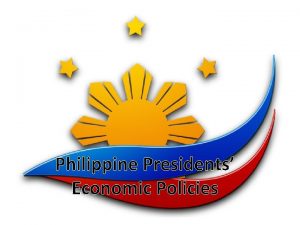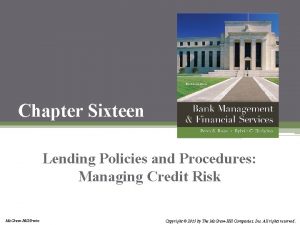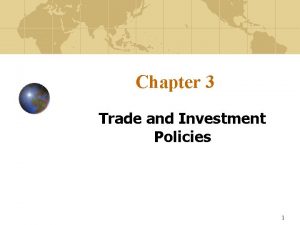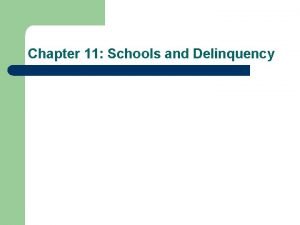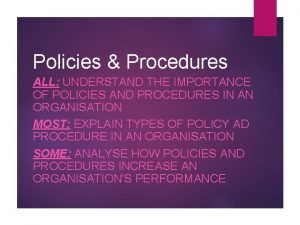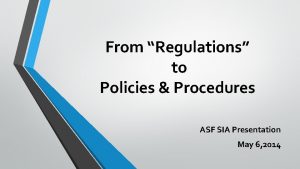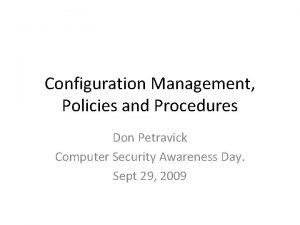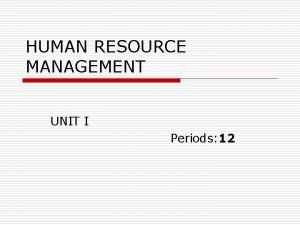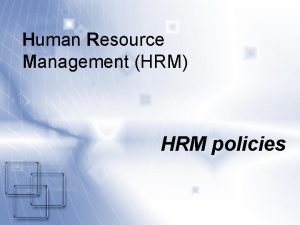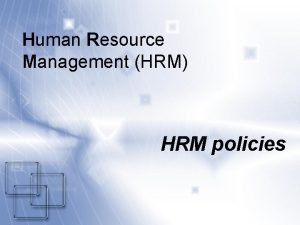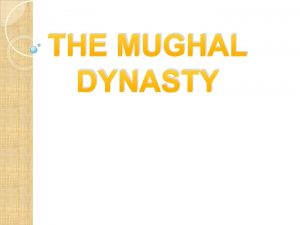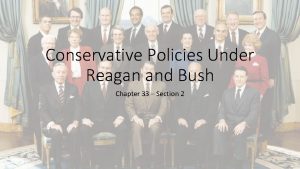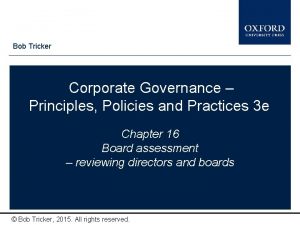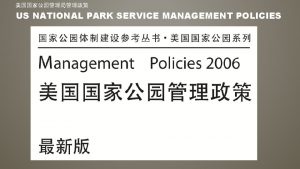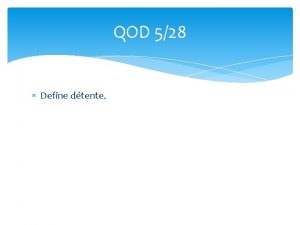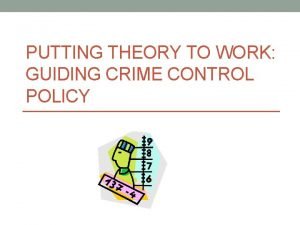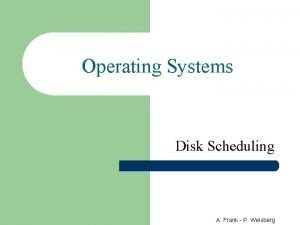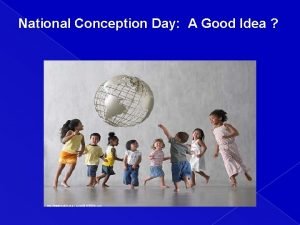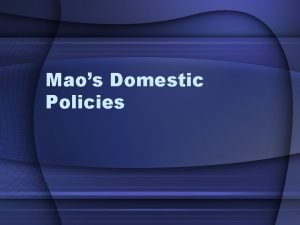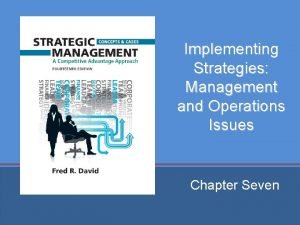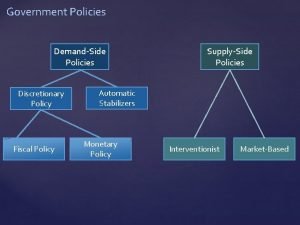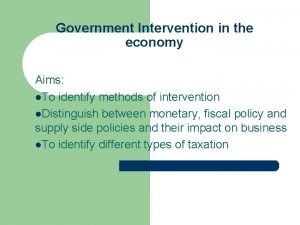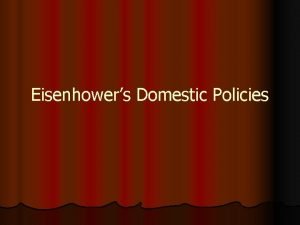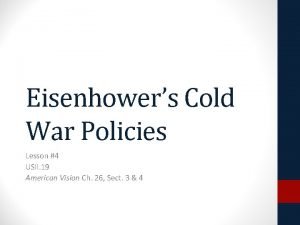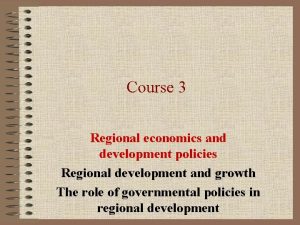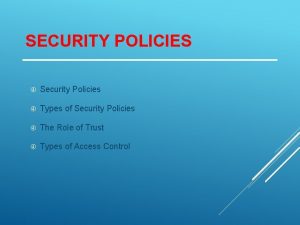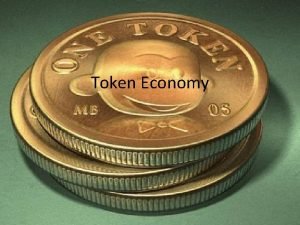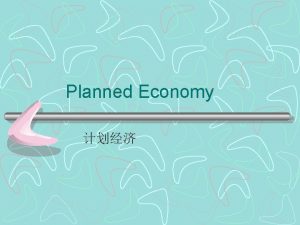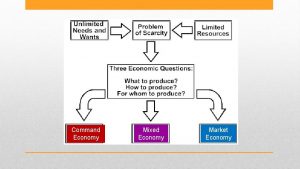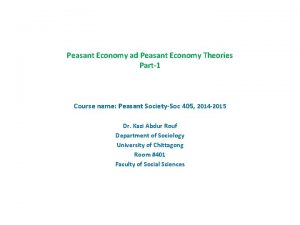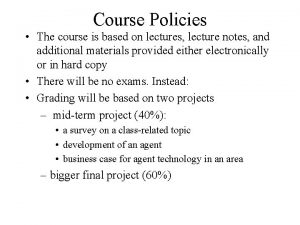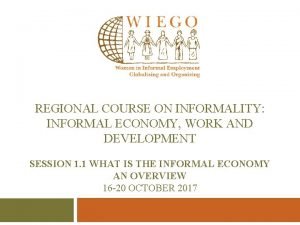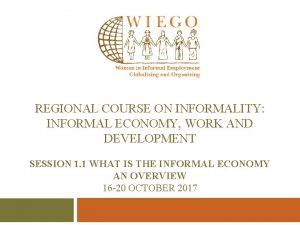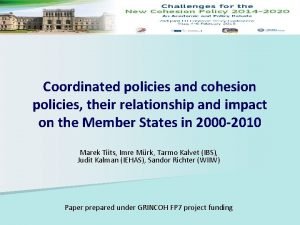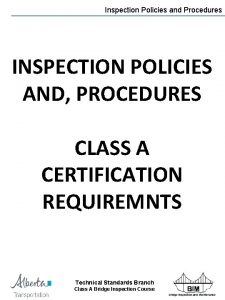Course 10 Regional Economy and development policies REGIONAL
















































- Slides: 48

Course 10 Regional Economy and development policies

REGIONAL DEVELOPMENT POLICY IN ROMANIA

When did regions appear in Romania? Initiatives to create “bigger entities that counties” - until 1859 and 1918: more historical regions 1938 – 1940: incipient regions – Ţinuturi 1950 – 1968: Regions 1947 - 1989: Authoritarian regime / centralized planning system 1995: Association to the EU 1998: Development regions

HISTORY – key moments ü 1996 – the regional development policy began to take shape once the PHARE programme became operational – elaboration of the “Green Book of Regional Development in Romania” ü 1998 – the legal framework of the regional policy was developed - Law 151 regarding regional development, establishes the objectives of the policy at national level, competencies and specific instruments for promoting regional development policy ü 2002 – the negotiating chapter 21 “Regional Policy” was opened – established the criteria that Romania had to fulfill in order to access the EU and its eligibility for structural funds. ü 2004 – a new law on regional development was adopted Law 315

Green Book of Regional Development in Romania • instituted a broad framework, in which the Romanian Government could introduce and implement the regional development activity. • preparation of a set of fundamental principles for developing the regional policy in Romania. • includes the proposals made by the Inter-ministerial Workgroup regarding the implementation of the regional development policy by the Romanian Government. CHAP 1: proposed the objectives of the policy. CHAP 2: presented the level of regional disparities and their trends taking into consideration the situation of the Romanian counties after 1990. CHAP 3: described the objectives and functions of the regional and competition policies, in the last years at EU level and some of its member states. CHAP 4: presented the institutional framework proposal for regional development policy and the necessary instruments for implementing this policy CHAP 5: suggested 9 steps in implementing the regional policy

Regions’ composition 1. North-East Bacau, Botosani, Iasi, Neamt, Suceava si Vaslui 2. South-East - Braila, Buzau, Constanta, Galati, Vrancea si Tulcea 3. South-Muntenia - Arges, Calarasi, Dambovita, Giurgiu, Ialomita, Prahova si Teleorman 4. South-West Oltenia - Dolj, Gorj, Mehedinti, Olt si Valcea 5. West - Arad, Caras-Severin, Hunedoara si Timis 6. North-West - Bihor, Bistrita. Nasaud, Cluj, Salaj, Satu Mare si Maramures 7. Center - Alba, Brasov, Covasna, Harghita, Mures si Sibiu 8. Bucharest-Ilfov - municipiul

• Law 151/1998 (replaced by Law 315/2004) proposed 8 Development Regions in Romania (NUTS 2 level) • DEVELOPMENT REGION: – a voluntary association of neighbouring counties, – the result of a free agreement between county and local councils, – it’s not an administrative-territorial unit – has no legal personality • Regions represent the framework: – for elaboration, implementation and evaluation of regional development policies – for collecting specific statistical data

Regional development objectives Law 315/2004 • In conformity with Art. 2. a), the first objective of regional development in Romania is: “reducing existing regional disparities, by stimulating a balanced development, by accelerated recovery of delays in development of disadvantaged areas due to historical, geographical, economic, social, political conditions, and by preventing the apparition of new imbalances” • preparing the institutional framework in order to meet the criteria of integration into the EU structures and to access the Structural and cohesion funds of the European Union; • Correlating Governmental sectoral policies and activities at regional level, by stimulating initiatives and harnessing local and regional resources in order to obtain sustainable socio-economic and cultural development of the regions; • Stimulating interregional cooperation, internal and international, crossborder cooperation, including within Euroregions, and the participation of the development regions to the European structures and organisations that promote economic and institutional development in order to elaborate and implement common interest (joint) projects, according to the agreements in which Romania is a part.

Institutional framework and the regional system of Romania

Ministry of European Funds coordination and management of European funds fonduri-ue. ro • cooperates with institutions involved in public procurement • cooperates with the Audit and the Certifying and Payment Authorities. • coordinates, together with the Ministry of Regional Development and Public Administration, the policy in the field of national growth poles in which there are priority investments from national and community financed programmes. • coordinates the elaboration, monitoring and evaluation of the National Reform Programme, the instrument for implementing the Europe 2020 Strategy.


Ministry of Regional Development and Public Administration http: //mdrap. ro/en/ MRDPA elaborates the Governmental policies in the following fields: – – – – Regional development Territorial cohesion and development Crossborder, transnational and interregional cooperation Spatial planning Urban planning Constructions Public works

Ministry of Regional Development and Public Administration • Programmes financed through European funds: Ø Regioanl Operational Programme Ø Administrative Capacity Operational Programme Ø European Territorial Cooperation Programmes (RO-UA, RO-MD, RO-BG, RO-SE, RO-HU, HU-SK-RO-UA, INTERREG EUROPE, URBACT III, INTERACT III, DANUBE) • Programmes financed through national funds: Ø Local Development National Programme (water systems and water treatment plants; sewerage systems and wastewater treatment plants, undergraduate educational institutions, rural health units, county public roads, local interest roads, communal roads and /or public roads within localities, bridges, footbridges or pedestrian bridges, cultural objectives of local interest (namely libraries, museums, multifunctional cultural centers, theatres), waste dumps, public markets, trade fairs, upgrading sports units)


INSTITUTIONAL FRAMEWORK (Law 315/2004) 1. The Regional Development Board (RDB) = the deliberative regional body, without legal personality, which is established and operates on partnership principles, at the level of each region, in order to coordinate the activities of elaboration and of monitoring resulting from the regional development policies. Main attributions: a) analysis and approves the regional development strategy and programmes; b) supports the elaboration in partnership of the National Development Plan; c) approves the regional development projects, selected at regional level; e) approves the criteria, priorities, allocation and destinations of the Regional Development Fund resources, and monitors their implementation; f) coordinates and supports the development of regional partnerships; g) endorses the contracts, conventions, agreements, protocols and other similar documents concluded by the RDAs in its specific field of activities with third parties, including with similar institutions of the EU

2. The Regional Development Agency (RDA) = a non-governmental and non -profit body, of public utility, with legal personality, operating in the field of regional development. Main attributions: a) elaborates and submits for approval to the Regional Development Board the regional development strategy, Plan, programmes and the planning of the management of the funds; b) ensures the implementation of regional programmes and the planning of the management of the funds, and is responsible for their achievement; c) submits requests to the national institution with attributions in the field of regional development, for amounts from the National Fund for Regional Development to finance the approved development projects; d) acts together with the Regional Development Board to attract resources in order to carry out their attributions; e) provides technical and financial management of the Regional Development Fund in order to achieve the objectives foreseen by the regional development programmes; f) is accountable to the RDB and to the national institution(s) with which it concluded contracts as well as to the bodies authorized by law, for the accurate management of the allocated funds; g) submits for approval to the RDB the projects selected within the regional development programmes on the basis of priorities, criteria and methodology elaborated by the national institution responsible h) identifies and promotes in partnership, projects of local and regional interest

North-West RDA http: //www. nord-vest. ro/north-west/

Programming • means the organising, decisionmaking and financing process carried out in a number of stages to implement on a multiannual basis the joint action of the Community and the Member States to attain the Objectives • ensures coordination of the Funds between themselves and with the other existing financial instruments, the EIB and the European Investment Fund (EIF). Such coordination should also cover the preparation of complex financial schemes and public-private partnerships • the programming period is to last for a single period of seven years in order to maintain the simplification of the management system • carried out at the level of the operational programmes and priority axes establishing objectives within a programme allocating funds for the necessary actions to fulfill the objectives

Programming Framework 1. Strategic programming • Objectives (Vision, medium and long time objectives) • Present situation (Profile, SWOT) – knowing and evaluating resources in the area • Priorities – strategic direction – image in the future • Programmes/sub-programmes - interconnected, linked and not directed to punctual, isolated developments – moving in the direction established by the priorities • Groups/packages of measures – contribute to the realization of the programmes and sub-programmes Next: defining target groups, development areas, financial framework and planning 2. Operational programming • Measures - activities • Projects – lead to the accomplishment of the development strategy

Project cycle management

Programming framework • Is given by some documents that describe the framework for implementing different: Ø European level – Community Strategic Guidelines + Europe 2020 Strategy Ø national level – Partnership agreement Ø national/regional level – Operational Programmes

The method: Programming, Partnership and Shared Management Common Strategic Framework Partnership Operational Agreements Programmes Management of Monitoring/ programmes/ Annual Selection of reporting projects

Five European Structural & Investment Funds (ESIF) working together PARTNERSHIP AGREEMENT European Agriculture Fund for Rural Development Cohesion Fund European Social Fund European Regional Development Fund • Common rules for ESI Funds – – – Simplified cost options. E-governance. Eligibility rules. Financial instruments. CLLD- Community –Led Local Development. European Maritime and Fisheries Fund

3 authorities to implement Cohesion Policy • A managing authority to implement the operational programme, and a monitoring committee to oversee it. • A certification body to verify the statement of expenditure and the payment applications before their transmission to the Commission. • An auditing body for each operational programme to supervise the efficient running of the management and monitoring system.

Institutional framework in Partnership Agreement

Partnership framework for the PA

Interinstitutional Committee for Partnership Agreement (CIAP) • organized and coordinated by the Ministry of European Funds • consulting role – represents the institutional forum which ensures the coordination of the national partnership framework. • promotes partnership in the elaboration of the programming documents for 2014 -2020, and of the Partnership Agreement and the subsequent programmes. • it operates both in plenary and section meetings, through meetings of the advisory committees • examines proposals and documents prepared within consulting committees and approves the grouping of intervention areas corresponding to each programming document, and also the main elements regarding the implementation, monitoring and evaluation of the interventions established within programming documents.

National institutional framework for 2014 -2020 http: //www. fonduri-ue. ro/ciap Advisory Committee on regional Development (CCDR), is coordinated in partnership by MEF and MRDPA. WG Urban development WG Energy efficiency WG Disadvantaged communities WG Regional and local infrastructure WG Business environment

Institutional framework for European funds management for 2014 -2020 Ministry of European Funds • Large infrastructure operational programme • Competitiveness operational programme • Technical assistance operational programme • Human capital operational programme • Disadvantaged people operational programme Ministry of Regional Development and Public Administration Ministry of Agriculture and Rural Development • Regional operational programme • Administrative capacity operational programme • Rural development national programme • Fishery and aquaculture national programme

Institutional framework for European funds management for 2014 -2020 Ministry of Transport MRDPA Ministry of Environment and Climate Changes Agency for financing rural investments Ministry of Economy Ministry of Labour, Family, Social Protection Department for infrastructure projects, FI, PPP Intermediate Bodies Regional Developm ent Agencies Department for Energy Tourism National Authority Ministry of Informatio nal Society Ministry of National Education

EU level 2007 -2013 Common Strategic Framework 2014 -2020 Common Strategic Framework and Europe 2020 Strategy National level 2007 -2013 National Reference Strategic Framework 2014 -2020 Partnership Agreement and National Reform Programme National level 2007 -2013 POR POS CCE POS T POS M POS DRU PO DCA PO AT PNDR POP PNDR PNPA Nivel național 2014 -2020 POR POC PO IM PO CU PO CA PO AT PO AD

Budget allocations per Member State (2014 -2020) 32

Partnership Agreement Romania 2014 -2020

National Reform Programme 2014 http: //ec. europa. eu/europe 2020/pdf/csr 2014/nrp 2014_romania_ro. pd f

National Reform Programme 2014 Public administration • • quality housing European funds management Public procurement Improving business environment • • financial and guarantee financing instruments technological capacity bureaucracy promotion and exports Employment • • efficiency and effectiveness of the ANOFM services EURES network labour force – adaptability and development creating jobs Research, development, innovation Environment and climate change • promoting RDI in sectors with growth potential • investments’ efficiency • floods • National Strategy on Climate Change Renewable energy • use • production Energy efficiency • improvement

National Reform Programme 2014 Education Social inclusion • • • education reforms and professional training, youth equal opportunities higher education life long learning • social assistance • health system – infrastructure and medical assistance at regional level

Partnership Agreement 2014 -2020 http: //ec. europa. eu/contracts_grants/agreements/index_en. htm

EC recommendations – financing priorities for Romania 2014 -2020 1. Improving human capital by increasing employment and better policies for social inclusion and education. 2. Development of a modern infrastructure for economic growth and jobs. 3. Promoting economic competitiveness and local development. 4. Optimize the use and protecting natural resources and assets. 5. Modernizing and strengthening administration and the judiciary system. national

Partnership Agreement Romania 2014 -2020 competitiveness and local development administration and governance Reducing economic and social development disparities between Romania and the EU member states resources people and society infrastructure

Partnership Agreement - development challenges Competitiveness Human capital and social issues Infrastructure Resources Administration and governance • • jobs RDI competitiveness ITC • employment • social inclusion and reducing poverty • education and training • transport • ITC • • • energy risks climate changes environment protection natural resources • quality public services • judiciary system • e-governance

Regional Operational Programme http: //www. fonduri-ue. ro/por-2014 ROP 2007 -2013 1. Support to sustainable development of urban growth poles 2. Improvement of regional and local transport infrastructure 3. Improvement of social infrastructure 4. Strengthening the regional and local business environment 5. Sustainable development and promotion of tourism ROP 2014 -2020 1. Promoting technological transfer 2. Improving small competitiveness and medium enterprises’ 3. Supporting the transition towards a low-carbon economy 4. Supporting sustainable urban development 5. Improving the urban environment and the sustainable conservation, protection and capitalization of cultural heritage 6. Improving road infrastructure of regional importance 7. Diversifying local economies through the sustainable development of tourism 8. Health and social infrastructure development 9. Supporting economic and social regeneration of disadvantaged communities in urban area 10. Improving educational infrastructure 11. Geographical expansion of the system of property registration in cadaster and land registry

Competitiveness http: //www. fonduri-ue. ro/poc-2014 IEC SOP 2007 -2013 1. An innovative and eco-efficient productive system 2. Research, technological development and innovation for competitiveness 3. ICT for private and public sectors 4. Increasing energy efficiency and security of supply in the context of combating climate change COP 2014 -2020 1. Research, technological development and innovation (RDI) in support of economic competitiveness and business development 2. Information and communication technology (ITC) for a competitive digital economy

TSOP 2007 -2013 1. Modernization and development of TEN-T priority axes aiming at sustainable transport system integrated with the EU transport networks Infrastructure LIOP 2014 -2020 2. Modernization and development of the national transport infrastructure aiming at sustainable national transport system 3. Modernization of transport sector aiming at higher degree of environmental protection, human health and passenger safety ESOP 2007 -2013 1. Extension and modernization of water and wastewater systems 2. Development of integrated waste management systems and rehabilitation of historically contaminated sites 3. Reduction of pollution and mitigation of climate change by restructuring and renovating urban heating systems towards energy efficiency targets in the identified local environmental hotspots 4. Implementation of adequate management systems for nature protection 5. Implementation of adequate infrastructure of natural risk prevention in most vulnerable areas Transport • Improving mobility by developing the TEN-T network and the subway • Developing a quality, sustainable and efficient multimodal transport system Environment • Developing the environmental infrastructure in term od efficient resource management • Environmental protection through measures for the conservation of biodiversity, air quality monitoring, and decontamination of historically polluted sites • Promoting adaptation to climate change, risk prevention and management Energy • Promoting clean energy and energy efficiency in order to support a lowcarbon economy • Increasing energy efficiency at the level of centralized heating system in selected cities • Intelligent and sustainable electricity and natural gas transport systems http: //www. fonduri-ue. ro/poim-2014

Human resources http: //www. fonduri-ue. ro/pocu-2014 HRD SOP 2007 -2013 1. Education and training in support for growth and development of knowledge based society 2. Linking life long learning and labour market 3. Increasing adaptability of workers and enterprises HCOP 2014 -2020 1. Youth Employment Initiative 2. Improving the situation of NEET (not in education, employment or training) youths 3. Jobs for all 4. Social inclusion and combating poverty 4. Modernisation of Public Employment Service 5. Community-led local development (CLLD) 5. Promoting active employment measures 6. Education and skills 6. Promoting social inclusion

Administrative capacity http: //www. fonduri-ue. ro/poca-2014 ACOP 2014 -2020 DACOP 2007 -2013 1. Structural and process improvements of the public policy management cycle 2. Improved quality and efficiency of the delivery of public services on a decentralized basis 1. Effective public administration and legal systems 2. Accessible and transparent administration and legal systems Technical assistance http: //www. fonduri-ue. ro/poat-2014 TAOP 2007 -2013 TAOP 2014 -2020 1. Support to the implementation of Structural Instruments and coordination of programmes 1. Strengthening beneficiaries’ capacity to prepare and implement ESIF funded projects, and dissemination of related information 2. Further development and support for the functioning of the Single Management Information System 2. Support for coordination, management and control of ESIF 3. Increasing the efficiency of human resources involved in the coordination, management and control of ESIF in Romania

Agriculture and rural development http: //www. madr. ro/docs/dezvoltare-rurala/programare-20142020/PNDR_2014_-_2020_01. 07. 2014. pdf NRDP 2007 -2013 NRDP 2014 -2020 1. Improving the competitiveness of agricultural and forestry sector 1. Modernization and increase in the viability of farms by strengthening them, market-opening and processing agricultural products 2. Improving the environment and the countryside 2. Encouraging rejuvenation of generations of farmers by supporting young farmers’ installation 3. The quality of life in rural areas and the diversification of the rural economy 3. Developing basic rural infrastructure as a precondition for attracting investments in rural areas and creating new jobs and implicitly developing the countryside 4. LEADER Axis 4. Encouraging the diversification of the rural economy by promoting the creation and development of SMEs in nonagricultural sectors in rural area 5. Promoting fruit growing sector as a sector with specific needs through a dedicated sub-programme 6. Encouraging community-led local development by LEADER approach

Operational programme for helping disadvantaged people http: //www. fonduri-ue. ro/poad-2014 • Areas: – food – school supplies • MA Ministery of European Funds • 520. 661. 186 Euro

Territorial cooperation programmes 2014 -2020 • • • Romania-Ukraine 2014 -2020 Romania-Moldavia 2014 -2020 Romania-Bulgaria 2014 -2020 Romania-Serbia 2014 -2020 Romania-Hungary 2014 -2020 Hungary-Slovakia-Romania-Ukraine 2014 -2020 Black Sea Basin 2014 -2020 INTERREG EUROPE URBACT III INTERACT III DANUBE 2014 -2020 ESPON 2020
 Athens and sparta were both
Athens and sparta were both Course number and title
Course number and title Stretcher bond t junction
Stretcher bond t junction Chaine parallèle muscle
Chaine parallèle muscle Ministry of regional development and public works
Ministry of regional development and public works Ministry of regional development and public works
Ministry of regional development and public works Entrepreneurship and regional development
Entrepreneurship and regional development Sdlc principles and practices
Sdlc principles and practices Bsbhrm506
Bsbhrm506 Security program and policies principles and practices
Security program and policies principles and practices Security program and policies principles and practices
Security program and policies principles and practices Security program and policies principles and practices
Security program and policies principles and practices Security program and policies principles and practices
Security program and policies principles and practices Hrtcc
Hrtcc Manuel roxas policy
Manuel roxas policy National policy and legislation
National policy and legislation Classroom policies and procedures
Classroom policies and procedures Lending policies and procedures managing credit risk
Lending policies and procedures managing credit risk Trade and investment policies
Trade and investment policies Modifying principles of accounting
Modifying principles of accounting Chapter 11 school policies and their functions
Chapter 11 school policies and their functions Importance of policies
Importance of policies Policies and procedures presentation
Policies and procedures presentation Configuration policies and procedures
Configuration policies and procedures What are hr policies
What are hr policies What are hr policies
What are hr policies Policies of human resource management
Policies of human resource management Who was babur
Who was babur Conservative policies under reagan and bush
Conservative policies under reagan and bush Chapter 6 supply demand and government policies
Chapter 6 supply demand and government policies Tricker corporate governance
Tricker corporate governance Leader safety course module 2 answers
Leader safety course module 2 answers Similarities between market and command economy
Similarities between market and command economy Nps management policies
Nps management policies Nixons foreign policies
Nixons foreign policies Crime control policies
Crime control policies What are policies
What are policies Disk scheduling policies
Disk scheduling policies Anti natalist policy
Anti natalist policy Lesson 2 activity 45 macroeconomics
Lesson 2 activity 45 macroeconomics Internally displaced persons ap human geography definition
Internally displaced persons ap human geography definition Fear be conquered
Fear be conquered Macroprudential policy
Macroprudential policy Crime control policies
Crime control policies The stamus company's hierarchy of aims
The stamus company's hierarchy of aims Demand side policies
Demand side policies Interventionist supply side policies
Interventionist supply side policies Eisenhower's domestic policy
Eisenhower's domestic policy Lesson 4 eisenhower's cold war policies
Lesson 4 eisenhower's cold war policies




